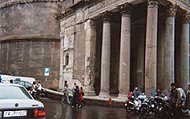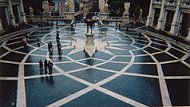|
Rome
|
At the end of 2002 World InfoZone was invited by the City of Rome to take part in the Global Junior Challenge event, a biannual exhibition of educational websites from around the world.
 The WIZ team decided to go to Rome a day before the exhibition (8 December). However, on arrival at Fiumicino Airport we discovered that the trains were not going to the city centre. It was a special feast day for Catholics and His Holiness Pope John Paul II was visiting the Piazza di Spagna to celebrate the day. As some of the train stations were closed we travelled by taxi, seeing the spectacular view of the Colosseum on the drive.
The WIZ team decided to go to Rome a day before the exhibition (8 December). However, on arrival at Fiumicino Airport we discovered that the trains were not going to the city centre. It was a special feast day for Catholics and His Holiness Pope John Paul II was visiting the Piazza di Spagna to celebrate the day. As some of the train stations were closed we travelled by taxi, seeing the spectacular view of the Colosseum on the drive.
When we arrived at the hotel, which was near Termini, we decided to make the most of our time and look at some of the sights. We took the bus to the Forum - only a short visit as it was getting dark. The approach to the Forum is overshadowed by the nineteenth century Victor Emmanuel Monument, known officially as the "Altar of the Nation". Steps lead up the Monument to the Tomb of the Unknown Soldier and an eternal flame guarded by two soldiers.
From the Monument it was not far to the Piazza di Spagna where Pope John Paul II had been earlier in the day. The Piazza was very busy and the Spanish Steps were covered with visitors. The poets Byron, Keats and Shelley all spent time in Rome and the Keats-Shelley House next to the Spanish Steps is where John Keats died in 1821.
The following day was free until late afternoon when we had to set up the stand at the exhibition. Our first visit was back to the Forum - the ancient centre of Rome - with ruins of basilicas, temples and triumphal arches. It is amazing that you can just walk in amongst most of the ancient monuments without paying an entrance fee and with no obvious security system guarding such an important World Heritage site.
 Leaving the Forum we walked through the city to the Pantheon which was built as a temple in the first century AD. The granite columns, outside the building, are enormous. Inside the Pantheon you can see a circular hole, known as an oculus, at the top of the dome. The oculus provides light. Although it was raining heavily outside you could hardly tell from inside. The floor is designed to let any rainwater drain away.
Leaving the Forum we walked through the city to the Pantheon which was built as a temple in the first century AD. The granite columns, outside the building, are enormous. Inside the Pantheon you can see a circular hole, known as an oculus, at the top of the dome. The oculus provides light. Although it was raining heavily outside you could hardly tell from inside. The floor is designed to let any rainwater drain away.
We also made visits to the Trevi fountain, Rome's largest fountain, the Santa Maria Degli Angeli (Michelangelo's last architectural work) with its meridian which was used for centuries to standardize Roman clocks, and the Church of Santa Maria della Vittoria with Bernini's carving of the Ecstasy of St Theresa.
In the early evening we took the bus to the Palazzo de Congressi, the venue of the two-day GJC Exhibition. During the event the mornings were busy with thousands of school children of all ages visiting the stands. The younger children in particular were very much at home with the Internet and it did not seem to matter that we did not speak much Italian.
On the evening before we were to leave Rome, the City of Rome kindly invited us to a restaurant in Trastevere (across the Tiber). All the people connected with the GJC met in the Piazza della Repubblica which is quite near Termini. Coaches were provided and we drove through the City looking at places of interest, such as the Old Jewish Quarter which is the oldest Jewish community in Europe where Jews have lived since the second century BC.
The whole of the basement of the restaurant had been booked for the exhibitors and people from workshops on the Digital Divide. We had a pleasant evening and were serenaded by a gypsy band which ended up singing "Arrivederci Roma" as we left. Although the official entertainment was good, one of the highlights of the evening was the performance of a group of young men who took over the stage: some Kenyans sang a lively song in their own language and were joined by newly made friends from the GJC who had learned the chorus.
 On the last morning the Final Event of the Global Junior Challenge took place in the Campidoglio City Hall, overlooking the Roman Forum. The Campidoglio, an important international venue, was designed by Michelangelo Buonarroti in the sixteenth century. The Piazza del Campidoglio, approached by the Cordonata, is decorated by Michelangelo's star or "Never Ending Path".
On the last morning the Final Event of the Global Junior Challenge took place in the Campidoglio City Hall, overlooking the Roman Forum. The Campidoglio, an important international venue, was designed by Michelangelo Buonarroti in the sixteenth century. The Piazza del Campidoglio, approached by the Cordonata, is decorated by Michelangelo's star or "Never Ending Path".
During the ceremony awards were made to some of the websites and announcements were made twinning Roman schools with schools in poorer regions of the world. Overcoming the Digital Divide is a major undertaking that is an educational priority for many organizations, large and small. World InfoZone provides access of its website free-of-charge so once a school or college has an Internet connection our educational information is readily available.
At the exhibition I was interviewed for an Italian television news channel and asked what I had enjoyed most about visiting Italy as a finalist in the GJC. My answer was that not only had it given us the opportunity to visit Rome but it had given us the experience of getting to know colleagues from many other countries and learn how they are making use of the Internet. Since returning to London, the World InfoZone site has also benefited as we have expanded country content at the request of fellow exhibitors who wanted information about their country on the site.
Addition May 2003: WIZ has been in contact with the Ein Ganim School who were also at the Global Challenge in December; together we have produced a Global Communication Feature. Addition November 2004: Rome 2004
|
|
|
|

